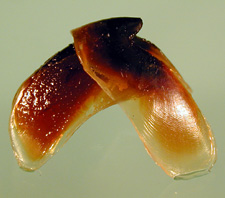Galiteuthis phyllura (DML=29cm) Galiteuthis phyllura (DML=54cm)  Octopus conyspadiceus Octopoteuthis sicula (DML=16cm) |
Beaks have a three-dimensional structure
therefore the shape appears different when viewed from different angles. Beaks from stomach contents usually have
damaged lateral walls and wings. When
identifying species from beaks it is necessary to select the characters that
are not easily damaged during digestion.
1. The size of the beak, the degree of pigmentation, and the color Beaks are usually dark brown to black in color. The pigmentation starts from the rostrum, the cutting teeth, and crest and spreads into the lateral walls and wings. The degree of pigmentation indicates the relative age of the individual. Small beaks that are almost completely pigmented indicate a small species while large beaks that are only partially pigmented indicate a large species.2. Shape of lateral wall The lateral wall is nearly rectangular or rhombic when observed from the side. A long, narrow, rectangular lateral wall indicates Octopodidae. A short, blunt rostrum is another important character for identifying beaks of Octopodidae. The lateral walls of Teuthiodea have a variety of shapes i.e. tall rhombic, narrow parallelogram, or hatchet-shaped. Some have a fold or ridge running obliquely from the ventral, anterior corner to the dorsal, posterior corner. 3. Shape of crest The profile of the crest ranges from a broad U-shape to a narrow V-shape. The proportion of crest length vs rostrum length is an important character. When observing the crest from the side it can be curved or straight or slightly curved, this is another important character. 4. Rostrum shape Beaks are roughly divided into four types depending on the proportion of rostral length of lower beak (RLL) to hood length (HL) i.e. RLL>>HL, RLL=HL, RLL<HL, and RLL>HL. Another important character is the shape of the cutting teeth. From the lateral view, the cutting teeth can be straight, gently curved, or hooked at the rostrum tip. 5. Shape of wing teeth and wing fold Beaks of young individuals have plate-like teeth that can have a variety of shapes including rhombic, trapezoidal, or narrow rectangular. The wing fold develops ontogenetically and groves develop between wing fold and wing teeth. Degree of development of the wing fold as well as the width and depth of wing fold are important characters. The angle between the cutting teeth and wing teeth is also important. 6. Shape of wing The wing is the last portion of the beak to be pigmented and is very thin therefore it is often damaged during digestion. The degree of projection and the shape of the wing are important characters. |
All Rights Reserved Kubodera, 2000